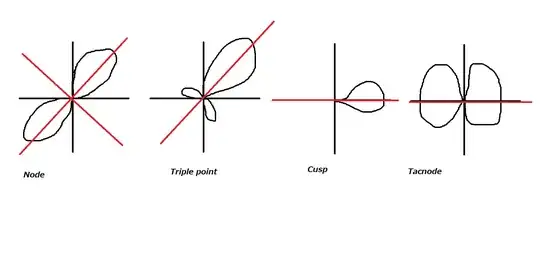Q Which is which in Figure?
a)$x^2=x^4+y^4$
b)$xy=x^6+y^6$
c)$x^3=y^2+x^4+y^4$
a)$x^2=x^4+y^4$
This is invariant under the transformation $x\mapsto -x$ and $y\mapsto -y$. Thus it is Tacnode.
b)$xy=x^6+y^6$
It is invariant under the map $(x,y) \mapsto (y,x)$, thus Node or Triple point.
Because triple points meat the small circle of origin in six times and six is the degree of this polynomial, thus I guess this curve is triple point but I cannot prove it in some precise manner.
c)$x^3=y^2+x^4+y^4$
This curve is invariant under the map $y \mapsto -y$ and it is not invariant under the map $x \mapsto -x$, thus Cusp.
d)$x^2y+xy^2=x^4+y^4$
It is invariant under the map $(x,y) \mapsto (y,x)$, thus Node or Triple point.
Because triple points meat the small circle of origin in 4 times and 4 is the degree of this polynomial, thus I guess this curve is Node but I cannot prove it in some precise manner.
I cannot answer for cuves b) and d).
